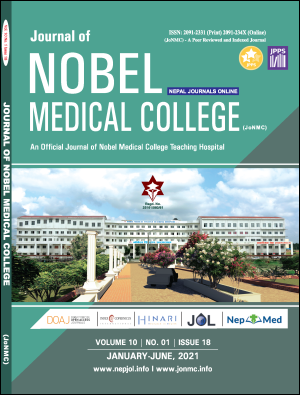Comparative Analysis between Martin’s Formula and Friedewald’s Formula with Direct Homogenous Assay for Estimating Low Density Lipoprotein Cholesterol Level in Nepalese Population
DOI:
https://doi.org/10.3126/jonmc.v10i1.37944Keywords:
Cholesterol, Low-density lipoprotein, TriglyceridesAbstract
Background: Low density lipoproteinforms a basis of decision making in treatment of hypercholesterolemic patients and primary target of intervention. Its cost effective and accurate measurementis a need for every clinical laboratories and different calculation methods has been adopted as a replacement to direct assays. This study aims to evaluate the Martin’s formula and Friedewald’s formula in a sample of Nepalese population compared against direct homogenous assay.
Materials and Methods: This is a cross-sectional study conducted in Department of Biochemistry from Feb 2020 to January 2021. Serum samples of the participants were analysed for total cholesterol, triglyceride, high density lipoprotein and low density lipoprotein. Martin’s and Friedewald’s formula were applied to get calculated value of low density lipoprotein from both methods. Passing and Bablok regression analysis was used for methods comparison.
Results: The mean age of participants was 54.2 ± 8.9 years. Passing-Bablok regression analysis showed Friedewald’s formula performed better than Martin’s formula as per systematic and proportional bias when compared with directassay. However at lowerserum low density lipoprotein level, underestimation of low density lipoprotein compared to direct assay was more common in Friedewald’s formula. At high triglyceride level more percentage error of difference of mean from direct assay was found for Friedewald’s formula.
Conclusion: When compared to direct assay, Friedewald’s formula was found to be in better agreement than Martin’s formula. Martin’s formula had advantage over Friedewald’s formula at lower serum low density lipoprotein level and higher triglyceride level where Friedewald’s formula mostly underestimated low density lipoprotein.
Downloads
Downloads
Published
How to Cite
Issue
Section
License
JoNMC applies the Creative Commons Attribution (CC BY) license to works we publish. Under this license, authors retain ownership of the copyright for their content, but they allow anyone to download, reuse, reprint, modify, distribute and/or copy the content as long as the original authors and source are cited.




